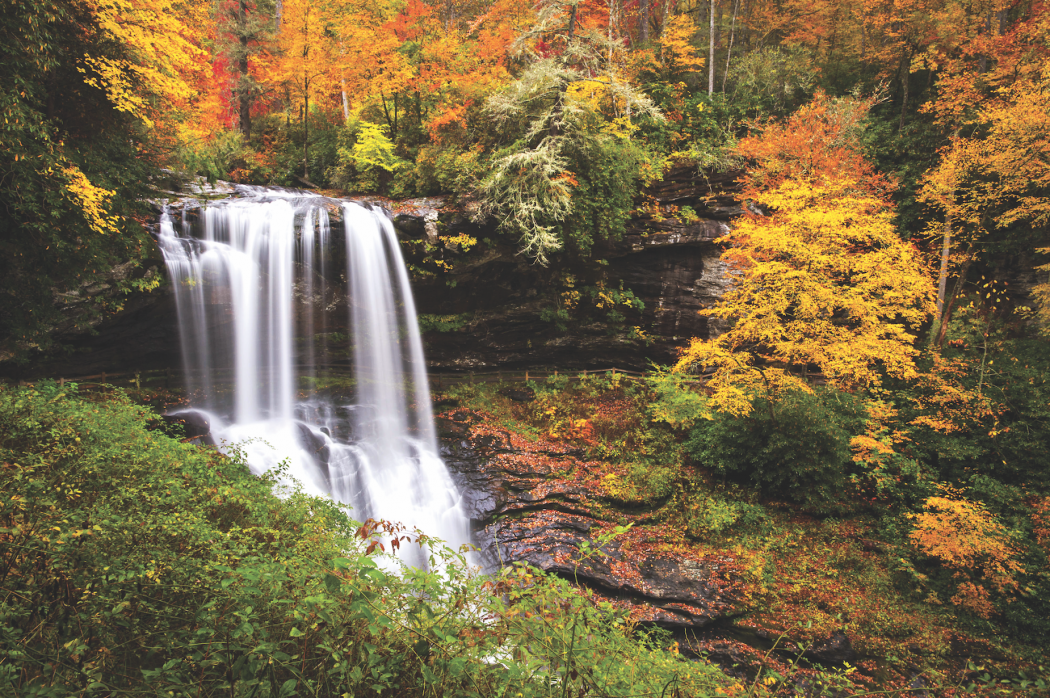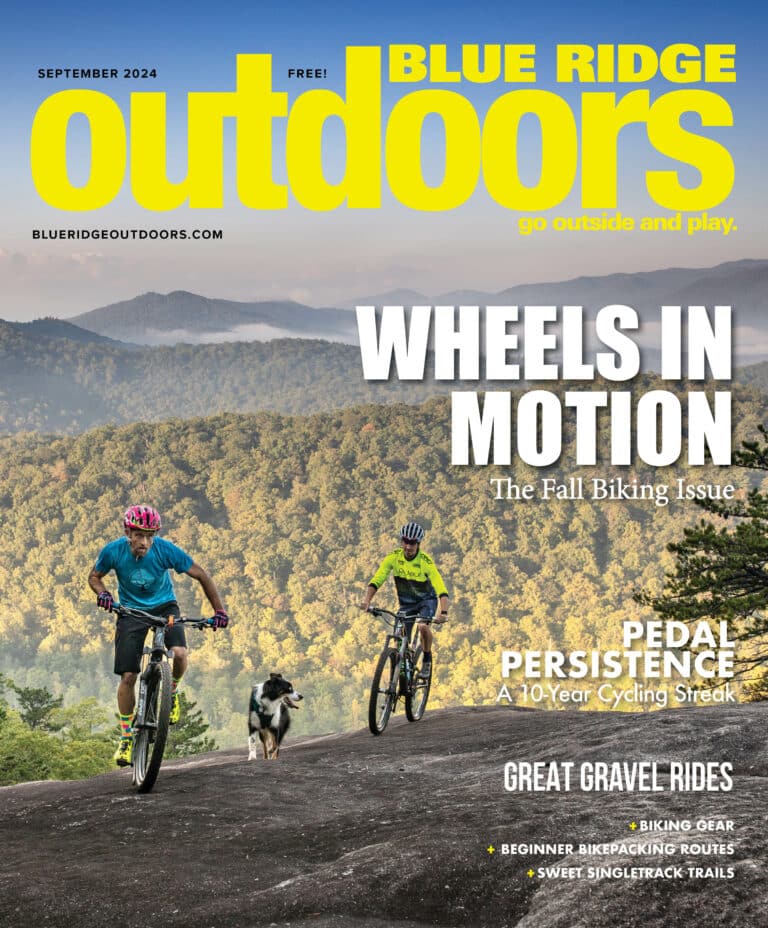Jennifer Loow said it barely mattered that the waterfall she was on her way to see—Lichen Falls, in Nantahala National Forest’s Panthertown Valley—had yet to be added to her lifetime list of 681.
Waterfalls are too beautiful and varied for mere tallying, she said. They can cascade or trickle, roar or sing. They flow over smooth boulders or craggy, fern-covered ledges. They create their own weather of mists and breezes. They inspire “almost spiritual” contemplation, she said, and give her such a rush that, on the short bushwhack leading to her first sight of Lichen, she wove through rhododendrons like a running back.
“Yeah!” she said, after climbing an outcropping at the base of the falls—“682, baby!”
For Loow, 43, seeking out and photographing waterfalls is a “lifestyle,” she said, the goal of tough, bushwhacking hikes she schedules at least once a week and sometimes squeezes in before her evening waitressing shifts at a Hendersonville, NC restaurant. Visiting waterfalls is hardly new, but Loow and other members of what she calls the “waterfall community” have in recent years transformed it into a pursuit like peak-bagging or birding, one that values doggedly collecting and counting new sightings.
There is no registry of its enthusiasts, no way to count their numbers, but they can be easily identified. They dislike sunshine, the glare of which ruins waterfall photographs, and have no problem wading hip-deep in cold water. Their hearts pound at the sight of lines on a map—blue streams meeting bunched topographical intervals—that promise a trip to an unnamed waterfall. Their cars rack up huge miles on mountain roads and, post-hike, are littered with trekking poles, camera tripods, and damp clothes and towels. Images of waterfalls dominate their Facebook feeds, which also, sometimes, display updates on other waterfall seekers’ lifetime lists.
This can inject an unwelcome strain of competition to a pursuit that should be all about appreciation, said Kevin Adams, author of the North Carolina Waterfalls guidebook. “Chest beating,” he calls it. But mostly lists do for waterfall hunters what they do for birders and climbers—propel people to explore nature.
“It’s overwhelmingly a great thing,” said Adams, 56, of Waynesville. “I think it’s wonderful that there are so many passionate people like Jennifer out there chasing waterfalls and using them to enrich their lives.”
Adams is in a better position than anyone to talk about the evolution of what he sometimes calls the “sport” of hunting waterfalls. His book is its bible and dog-eared, highlighted copies often make up part of the clutter in waterfall seekers’ cars.
After the first edition was published in 1994, he received notes from the pursuit’s lonely pioneers, including an old man who sent him a hand-written list of more than 300 falls he had visited—“quite an accomplishment,” Adams said, “considering his age and the fact there was no information available for many of the waterfalls on his list.”
An expanded edition was published in 2004, the same year as the founding of Facebook, and together they have provided what that old man had lacked—instructions about how to find waterfalls and a connection to other people who love them.
The one-time trickle of letters Adam had received became an “explosion” of emails and online postings, he said. He also noticed that as more people knew what the sport was all about, the less explanation was needed in its name. As “bird watchers” became “birders,” “waterfall chasers” became “waterfallers” and their hobby “waterfalling.”
It can never quite be like birding or peak-bagging because it defies standardization, said Adams, who released a third edition of his book last year. There is no firm definition of a waterfall, nothing to prevent a lister from counting one, three-tiered waterfall as three, one-tiered waterfalls.
It is, however, unlimited in another way. Adams—who doesn’t keep a personal list but says he has easily visited 1,000 falls just in North Carolina—is the undisputed king of southern Appalachian waterfallers. But even he could never hope to see them all.
“Goodness no, no one ever will—never, ever, ever,” he said. “That’s what makes this sport of ours so fascinating and so fun. We know it will never end.”
You can be a waterfaller without seeking just waterfalls, said Brenda Wiley, of Brevard, a veteran hiker who loves mapping out waterfall hikes, who scowls at sunbeams that appear once she is set up behind her viewfinder, who is even a member of an informal group of hikers called Team Waterfall. But she also likes to hike through mountain meadows, she said, and walk “along abandoned logging roads with no particular destination.”
When Loow hikes, on the other hand, “my destination is almost always a waterfall,” she said. And though she is warm and sociable, talking fondly of her coworkers and adoringly of her husband, adult son, and a pet lionhead rabbit she named after a Norse goddess, she almost always hikes alone.
This adventurous streak grew slowly after she received a copy of Adams’ book in 2009. “It sort of sat on the shelf for a year before a light bulb went off in my head,” she said. She started to realize how close her Henderson County home is to the rain-drenched mountains that are more densely packed with waterfalls than any region in the country. And though she was initially intimidated to take on any waterfall hike that earned more than a 7 on Adams’ one-to-10 scale of difficulty, she quickly gained confidence and now embraces hikes that test her endurance and her ability to manage the danger that comes with scrambling around waterfalls.
“The more difficult they are,” she said, “the more I love it.”
Loow is fit-looking and shorter than average, but carries a larger-than-average backpack, which she needs to hold climbing rope, tripod, and a large, professional-grade Canon camera. The initial, well-traveled stretch of the hike to Lichen she covered at a pace meant to get it over with. “Trails, to me, are a necessarily evil,” she said. She raced through the bushwhack not just because she was eager to add Lichen to her list, she said, but because she loves finding the best route through such obstacle courses of fallen trees and underbrush.
“Bushwhacking and creekwalking—that’s the best part,” she said.
In fact, her score-keeping—and smiling, and self-aware—celebration at the base of Lichen was about the only sign that she cared about the list at all. After the stop at Lichen, she would wade up the Tuckasegee River to visit two falls she had already seen, Red Butt and Wardens Falls. “Old buddies,” she called them. And she told about the three-year wait required to capture the perfect picture of what is easily the most visited cascade in Panthertown, Schoolhouse Falls. She drove her Toyota Yaris (350,000 miles) there at dawn one snowy morning before the falls was marred with a single footprint. “I don’t know who I was talking to on the way home, but I just kept saying, ‘Thank you, thank you, thank you.’ ”
And when she did reach Lichen, she didn’t just add it to her list and move on. She lingered. She photographed it from several different angles. She waded into the pool beneath its main drop, letting the water fall into her upturned palms. She gazed at it to consider whether it deserved Adams’ 7 rating for beauty.
It did, she decided. It’s on a tributary of the Tuckasegee, meaning it lacks a dramatic torrent. But falls over ledges are her favorite kind and Lichen appears suddenly in a deep notch in a shelf of rock 30 feet above the river. Loow pointed to the moss and plants clinging to more ledges farther below. She admired the way the falls’ curtains of water broke into shining beads.
“It’s the setting that makes it,” she said. “It’s not a big waterfall, but it’s dainty and it’s really beautiful.”








